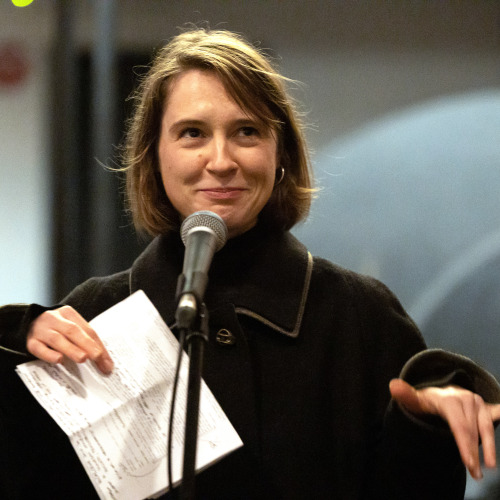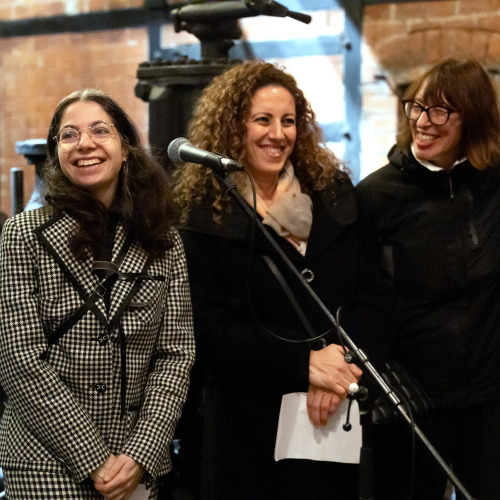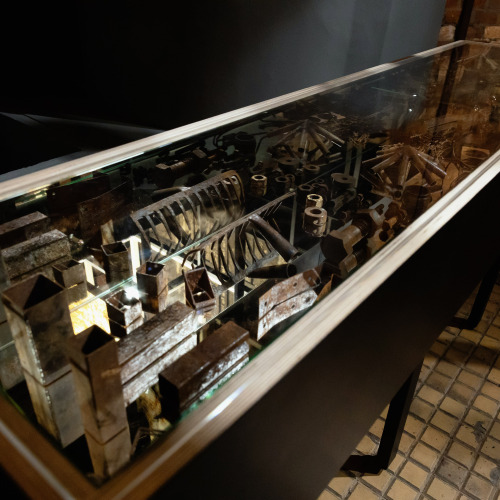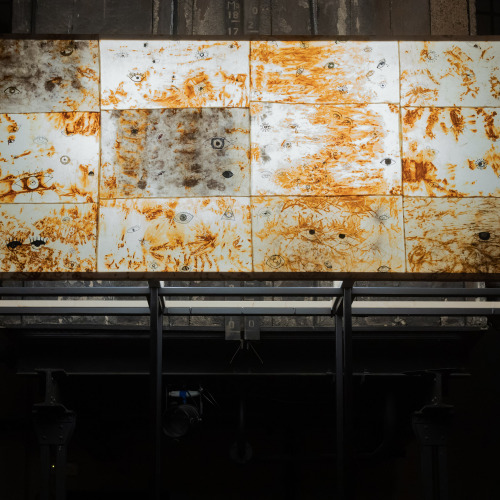

Erased Gazes
To protest the injustices caused by the erasure, marking its 30th anniversary, the artistic collective of the Politics of Touch project initiated by the City of Women made a memorial entitled Erased Gazes ~ Izbrisani pogledi.
A group of women, who come from various parts of the world but now call Ljubljana, Logatec, and Zagreb home, created a memorial canvas dedicated to the erased during workshops led by selma banich between July and December 2022 in Slovenia and Croatia.
The canvas is made of fabric which has been rust-printed with objects collected from the sites of past and present erasures (Krvova placa in Vinež, Metelkova in Ljubljana, Brodarski Institute in Zagreb), and decorated with a slow-stitched, multi-coloured, collaboratively made eye-shaped embroidery that returns the gazes of the erased back to the world.
The opening ceremony of the Erased Gazes ~ Izbrisani pogledi memorial was held during a cycle titled Myths and Medusas, organised by the City of Women at the Old Power Station in Ljubljana in December 2022. The memorial will be donated to the reorganised National Museum of Contemporary History of Slovenia (united with the Museum of Slovenian Independence), with the aim of bringing a parallel story and forgotten history to the established narrative of Slovenian independence.
PROCESS
The workshops Politics of Touch took place in June 2022 at the seat of the City of Women. All the participants first introduced themselves, sharing their experiences and backgrounds. After a discussion and on selma banich’s initiative, Mirjana, Slavica, Ivana, Aber, and Ana decided to make a memorial for all the people with the shared experience of an erasure. For most of the co-creators, the meaning of erasure is twofold. It combines the erasure that happened in Slovenia in 1992 with the erasure of people on the move who have had to flee from their countries because of war, economic crises, discrimination, censorship, or state violence. The workshop included only participants that identify as women – as besides ethnic, racial and class-based discrimination, women also share an experience of gender-based violence or abuse, rooted in a patriarchal history. One of the ways to fight against it, is by creating a strong sisterhood, which can be built through artistic co-creation.
In Slovenia, the term ‘erasure’ refers to a systematic process that happened after the declaration of Slovenia’s independence whereby many people’s legal status was taken away. It is an example of administrative genocide. Jasminka Dedić defines it as legalised discrimination that resulted in a split between citizens and non-citizens. In the case of Slovenia, this split happened because on 26 February 1992 the state took away the former status of 25,671 people without any legitimate or objective reasons (for more information, see the book Izbrisani by Jasminka Decić, Vlasta Jalušič and Jelka Zorn). These people were erased from the register of permanent residents in Slovenia, so their status became similar to the status of foreigners, although many of them lived, worked or/and were even born in Slovenia. After that, people lost their health insurance as well as their civil rights – they could neither work legally nor vote. This economic and state violence also influenced their psychological stability, making them afraid to speak up about their stories in public. Their fear and silence were the reasons why it was so hard for them to organise politically. Some of them have nevertheless fought back against the authorities and clearly pointed out the injustices that have happened. One of them was certainly Mirjana Učakar, one of the most visible fighters for the rights of the erased, who participated at the beginning of the project but unfortunately died of cancer during the artistic process. Slavica is also one of the erased who became activists, while Ivana, who shares a similar experience because her father was erased, is a representative of a younger generation. The meaning of erasure, however, extends even beyond its historical and local dimensions. Administrative violence happens on an everyday basis to foreigners who have had to leave their countries, a reality which corresponds to Aber’s experience. This is why the memorial also has the added dimension of protest and includes the erasure of animals from the planet and the erasure of public spaces.
These political, social, and extremely personal experiences of erasure are expressed on a cloth divided into twelve parts. The artistic collective created it by putting rusty objects in cloth, wrapping it and putting it first in vinegar and later in boiling water. The rusty objects left their brown and yellow imprints on the fabric, leaving many interesting patterns and abstract images. After a long discussion, the collective decided to sew eyes on it – because eyes, staring from the cloth, challenge spectators. They confront people with a forgotten part of Slovenian history and everyday state violence. They watch our acts, they call for responsibility, they warn and remind us how our politics still erase people on the move, how they violate them, physically, psychologically, and bureaucratically. Moreover, every person that sewed eyes on the cloth, did it while thinking of someone. The eyes were dedicated to different people or communities. Ivana wrote:
“I dedicate the protest memorial canvas to all the victims of global systemic oppression, but especially to the victims of the administrative genocide of 1992. The erasure is still alive and appears daily in various discriminatory practices. For this reason, the canvas is commemorative and rebellious, but at the same time, for me, it also has the function of connection and empowerment. Its creation brought together extraordinary women who can be an inspiration to us all because of their unwavering strength. During the process of making the canvas, bonds were formed between us that reflect solidarity and love and instil courage and hope.”
Slavica focused on future generations:
“I dedicate this work to the erased children because they were once, together with their parents, pushed into a deep black pit by the authorities of the time, for no reason and without mercy. Even children carry the stains of erasure. It’s not an unprecedented crime. We remember and are still watching you! We were oppressed, humiliated, spat on, and robbed of our human rights.”
The Erased Gazes memorial was made collectively, decisions were made together – selma banich as the leader and workshop organiser was open to new ideas and careful with suggestions. Each of the participants contributed in her own way, so this work is a result of gentle co-creation. For example, Aber knew more about sewing and her aesthetic approach helped us a lot. Slavica came up with unique ideas and was very precise. Ivana is skilled at summing things up and putting them into context. Besides this, the collective shared its work with others who participated with sewing, for example refugee women in Logatec and women from a collective called Centar za žene žrtve rata – Rosa based in Zagreb. This piece of art connected people. Simple skills could be passed on to other women and prior knowledge was not a necessary condition to participate. What is more, many contributors were even more adept at sewing than the collective. The canvas is the result of co-creation and an example of an inclusive, decentralised, and partly non-hierarchical process.
At the end of the project, the threads that are still weaving among the creators of Erased Gazes, were sewn into poetry by Aber Alengdy:
“Schizophrenia”
I am surrounded by fear
Death
Ignorance
Legitimacy
What’s declared of it, and what’s hidden
A beauty surrounds me, like the sand of the desert
It escapes me a grain at a time
I am surrounded by femininity
Fertility
Globalization
and the trendy colours
I escape, I run, I trip over, I fall, I stop, I dream, I get tired, I get up
I fold dreamy paths up
Paths of Athens, Greece, and Andalusia
I breathe ancient oriental glory
I breathe Aphrodite
I breathe Al Qadmus and its Greek alphabet
I am here
Not there
And the saltness of the sea here is not like the saltness of the sea there
The roses there ration their fragrance
And the fragrance here is a sea
I have loved ones there
I have loved ones here
My mother waters basil seedlings there
Here, I forgot my heart
Who am I?
Gather the fragments of the soul
And from the threads of your fear, weave a dress for the eternity
Keep the identity
Grab your compass,
and direct your sails
O longest conversations of heaven
O womb in which the prophets were formed.























